Data assimilation (DA) is used in numerical weather prediction (NWP) to establish the initial conditions of forecasts based on the latest observations and an earlier short-range forecast. A new approach for exploiting satellite radar altimetry sea-surface height (SSH) information in a coupled DA system has been investigated as part of the German National Meteorological Service's (DWD's) STEP UP! Fellowship programme for ECMWF. One of the Fellowships from 2023 to 2025 built upon preliminary ideas developed at ECMWF: the project was based on recognising that the 'atmospheric delay corrections' currently applied in the retrieval of ocean SSH information from altimeter measurements are essentially the same information as the ground-based Global Navigation Satellite System (GNSS) observations now assimilated in many operational NWP systems, which provide useful humidity information over land. Therefore, it was investigated whether, instead of correcting the altimeter measurements, it is possible to retrieve potentially useful humidity information over the ocean in a similar way to ground-based GNSS. This has required running a complex, state-of-the-art coupled data assimilation system. Some of the initial, proof-of-concept results are reviewed here, and areas for further work are suggested.
Until relatively recently, we usually characterised observations as ocean, atmosphere or wave observations, based on which assimilation system the observations were going to be used in. However, the move towards an Earth system approach, exploiting an increasingly coupled model and data assimilation framework, means that some of these distinctions are being reconsidered. We now talk about using 'interface observations', which are sensitive to more than one component of the Earth system and may have been under-exploited to date because of this additional complexity. Improved use of interface observations was the subject of an important NWP Satellite Application Facility (SAF) workshop hosted by ECMWF in 2024 (see https://events.ecmwf.int/event/420/). For example, at the workshop it was shown how microwave and infrared radiance measurements used in the atmospheric DA system are now also being used to constrain sea-surface temperatures and sea-ice concentrations. It was also shown that ocean current information improved the use of scatterometer wind retrievals in the atmospheric system.
Altimeters can also be considered interface observations, and in this work we have been investigating whether the developments in coupled DA mean more useful information can be retrieved from these measurements.
The use of altimeter measurements at ECMWF has been discussed before by Saleh & Zuo (2016). Briefly, altimeters on satellites emit electromagnetic pulses vertically downwards, towards the ocean's surface, and then measure the reflected signal (see Figure 1). The time taken for the signal to travel to the sea surface and then back to the satellite provides information on SSH, assuming we know the position of the satellite accurately. Other characteristics of the received signal provide important information related to significant wave height (SWH) and near-surface (10 m) wind speed. Currently at ECMWF, SSH information is assimilated in the ocean data assimilation system, SWH is assimilated in the wave system, and wind speed information is used for verification. The Fellowship work has focused on SSH information retrieved from altimeters.
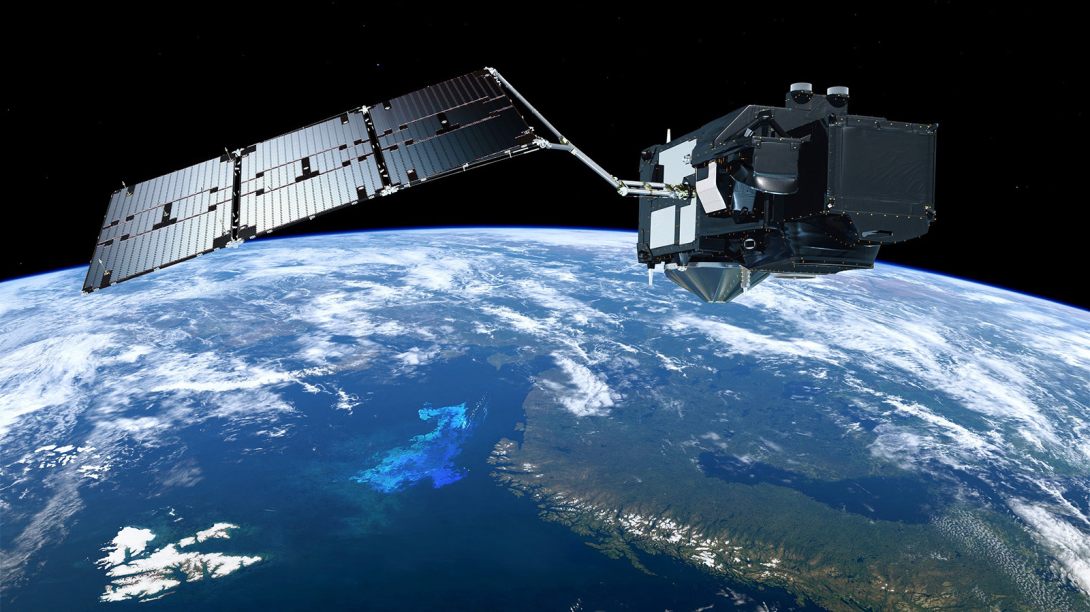
Retrieving altimeter sea-surface height information
A series of 'corrections' is required before accurate SSH information can be derived from the transit times of the altimeter signals. These corrections include accounting for instrumental issues, tidal effects, the interaction with the sea surface and various other geophysical effects. The set of geophysical corrections also includes terms accounting for the delays in propagation time introduced by both the ionosphere (about 90 to 965 km above sea level) and the neutral atmosphere below (see Fernandes et al., 2021, for a more detailed discussion).
The ionospheric delays can usually be estimated accurately because the altimeter emits signals at two frequencies, usually either a Ku-band or Ka-band and C-band. The ionosphere is 'dispersive', meaning that it affects the propagation times of the two signals slightly differently in a known way. This is why the ionospheric signal can be isolated by taking a linear combination of the two measurements. Although this represents noise in the context of altimeter processing, it is useful information about the ionospheric state below the altimeter in the form of a vertically integrated total electron content (VTEC) estimate.
The additional path delay (PD) caused by the neutral atmosphere is usually partitioned into a 'dry' path delay (DPD) and a 'wet' path delay (WPD). By convention, the negative of these quantities represents two corrections applied in the processing, and these are called the 'dry tropospheric correction' (DTC) and the 'wet tropospheric correction' (WTC). These corrections are called 'tropospheric' because most of the delay occurs there, but they also contain a small stratospheric component.
The dry term is the largest, typically around 2.3 m or around 80-90% of the total path delay (we convert a time delay to distance by multiplying by the speed of light). However, it has relatively low variability and it can be predicted and corrected accurately using surface pressure information from an NWP analysis or forecast. In contrast, the wet delay/correction is more variable, ranging from 0 to 35 cm. To a reasonable approximation, the wet delay is linearly related to the total column water vapour (TCWV) at the observation location (TCWV = 0.16 WPD is a useful rule of thumb).
The WPD/WTC used in the altimeter preprocessing is usually estimated using a geophysical retrieval based on radiances from a microwave radiometer flown on the satellite with the altimeter. When a radiometer is not available, NWP-based correction can be applied.
Ground-based GNSS measurements
Ground-based GNSS (also referred to as 'ground-based GPS' or 'GPS meteorology') measurements have been assimilated at operational NWP centres for many years (e.g. Poli et al., 2007). They became operational at ECMWF in 2024 with the introduction of IFS Cycle 49r1.
This measurement technique first emerged in the 1990s with a pioneering paper by Bevis et al. (1992). In this work, they explained how geodesists using GPS needed to correct for propagation delays caused by both the ionosphere and the neutral atmosphere. They noted that scientists were beginning to use these GPS measurements to study the ionosphere. They discussed whether similar applications could be found for the neutral atmosphere, in particular estimating TCWV. More broadly, they posed the question whether the neutral atmospheric delay was a source of geodetic noise or meteorological signals.
In subsequent years, ground-based GNSS networks became fundamental for monitoring the ionospheric state. This data is now routinely used in operational limited-area and global NWP, primarily providing TCWV information over land.
The ground-based GNSS quantity assimilated at most NWP centres is called the zenith total delay (ZTD). Although the naming convention differs, this is equivalent to the sum of the delay terms (ZTD = PD = DPD + WPD) identified in the altimeter corrections. The GNSS ZTD can also be partitioned into the sum of zenith hydrostatic delay (ZHD) and zenith wet delay (ZWD) to aid interpretation and comparison, where clearly ZHD = DPD and ZWD = WPD, but this partitioning is not required when assimilating the data as the combined ZTD. It should also be noted that GNSS zenith information is usually estimated by fitting multiple 'slant delays', for non-vertical signal paths from the GNSS transmitter to receivers on land. So, in some sense, the GNSS information we currently assimilate is based on a more complex measurement geometry than the analogous altimeter corrections.
To summarise, the similarities between the corrections applied in the processing of altimeter SSH information and the quantity assimilated in ground-based GNSS are clear and well known. In fact, ground-based GNSS ZWD information can be used to improve the altimeter wet delay correction in coastal regions, where the radiometer-based retrieval can become contaminated by land and difficult to use. However, as far as we know, no one has tried to assimilate altimeter measurements in an NWP system to provide TCWV information over the ocean as if they were GNSS measurements, but with the additional complexity of an unknown surface height.
Data used for this study
The EUMETSAT level-2 altimeter data for Sentinel-3A and -3B is used for this work. These datasets are ideal for this research project because they contain all the altimeter corrections applied, meaning we are able to pick and choose which corrections we want to apply for this particular application. In practice, we use all the corrections provided in the EUMETSAT files, except for the dry and wet delay corrections.
For the purposes of this work, a new assimilation variable has been defined that is sensitive to both the atmospheric state and SSH. Currently, at ECMWF this variable is called sea surface to satellite delay (S3D), primarily to avoid confusion with ZTD and PD. It can be written as S3D = ZTD – SSH, where SSH is the absolute sea-surface height above a geoid.
When processing the EUMETSAT level-2 altimeter observation information to S3D, the dry and wet atmospheric corrections are effectively added back to sea level anomaly (SLA) values. Note that the level-3 SLA is the quantity usually assimilated in ocean DA systems, such as NEMOVAR used at ECMWF. The S3D values are defined as relative to the geoid and this must be reflected in the measurement processing. The approach adopted here is mathematically equivalent to the current method used for SLA assimilation. More specifically, the observed SLA values are given relative to a two-dimensional mean sea surface field (MSS) above a reference ellipsoid. The MSS is derived from the mean value of observations taken over an extended period. In contrast, the anomalies simulated in ocean DA systems are given relative to a two-dimensional mean dynamic topography (MDT) field, derived from the ocean forecasting system. The MDT is computed by running the ocean forecasting system for an extended period - ideally the same period used for the MSS estimate – but only assimilating a subset of observations. The implicit assumption here is that the MDT is given relative to the geoid, even though the actual, rather complex geometrical shape of the geoid is not used in ECMWF's NWP systems.
This formulation of the SLA assimilation problem – where we compute the difference between the observed and simulated anomaly information – is equivalent to assuming the observed information is given relative to a geoid model, G, defined as G = MSS – MDT. Therefore, in the S3D processing, we use both the model MDT and the observed MSS in the observation processing to provide the S3D values relative to G = MSS – MDT. We have tried using other geoid models to produce the S3D values, such as EGM2008 and GOCO06s, but to date the MSS – MDT approach appears to provide the smallest biases when computing the S3D departures in experiments.
The S3D values are then converted to a ground-based GNSS format using the EUMETSAT ROM SAF 'GBGP software' (see https://rom-saf.eumetsat.int/gbgp/). They are then ingested and processed in the same way as ground-based GNSS information when running the assimilation experiments.
Assimilating the S3D values
A schematic of the assimilation system used to test the S3D measurements is shown in Figure 2. When a measurement is assimilated, we need to reproduce it by simulation – or 'forward modelling' – using information provided by the forecasting system. This is because we compute the differences between the measured and simulated values during the assimilation process, in order to update the forecast given the new observations and produce an improved estimate of the state (the 'analysis').
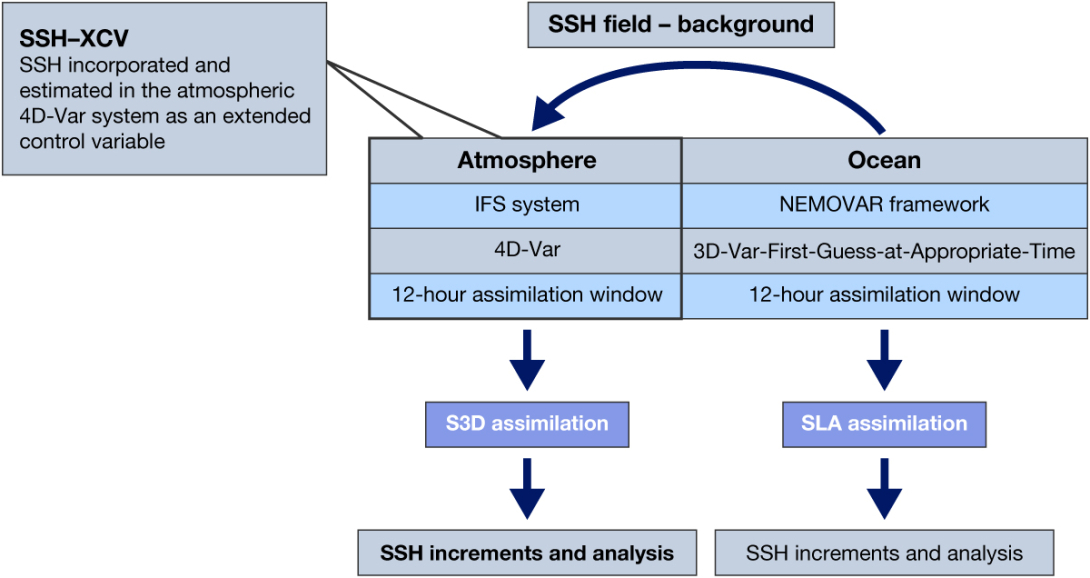
As described above, by construction S3D = ZTD – SSH, so both atmospheric and ocean state information must be available when simulating – or 'forward modelling' – the S3D values within the DA system. Computing the ZTD part is relatively straightforward because we already have this forward model available for the ground-based GNSS assimilation. The use of SSH, and making it available within the ground-based GNSS system, exploits more recent developments in coupled DA.
As shown in Figure 2, the ocean DA system, NEMOVAR, is run in parallel (outer-loop coupling) with the atmospheric 4D-Var DA system. NEMOVAR assimilates all the available SLA information and other sea-surface temperature and salinity observations for this period in the standard way. It provides a short-range forecast of the two-dimensional SSH field (or 'absolute dynamic topography', ADT) that is passed to the atmospheric 4D-Var system, using the extended control variable (XCV) framework.
Briefly, the XCV is an important generalisation of 4D-Var because it enables additional parameters to be appended to the normal, atmospheric state vector (Massart et al., 2021). This generalisation means we are able to adjust both the atmospheric state and the SSH values stored in the XCV when producing the 4D-Var analysis. Note that the SSH analysis in the XCV is not 'cycling', so an estimate of the SSH in the XCV at a given time does not influence the XCV SSH at a later time.
Experiments
The proof-of-concept assimilation experiments with the new Sentinel-3A and -3B S3D information cover the period of 7 June to 30 August 2020. The S3D values are thinned to 28 km horizontal separation, and they are only used in the latitude range between 60° north and 60° south. The assumed observation uncertainty of the S3D values is 3 cm, and the assumed standard deviation of the XCV background error of the SSH from the NEMOVAR forecast is 4 cm. The XCV background error correlation matrix assumes an exponential decay with a separation distance, assuming a 50 km horizontal scale length. These uncertainty specifications are a reasonable first step, but they can probably be improved in future work.
Figure 3 illustrates the typical S3D coverage for a 12-hour assimilation window on June 7, 2020, with the colour shading illustrating the increments in S3D space for the observation tracks. More generally, Figure 4 shows the spatial map of the S3D observation minus background (o–b) and observation minus analysis (o–a) root-mean-square (RMS) departure statistics averaged over the three-month period. The spatially averaged RMS value of (o–b) is 5.7 cm, but this is reduced to 3.2 cm for the (o–a) statistics. This indicates that the assimilation system is able to move the combined ocean/atmosphere state estimate towards the observations quite effectively. It is interesting to compare the values of these departure statistics with those typically found for ground-based GNSS ZTD observations. In the northern and southern hemispheres, there are clear seasonal variations, with larger values in summer than winter, but the RMS value of (o–b) is typically around 0.8–1.2 cm. It is larger in the tropics, with a value around 1.8 cm. The S3D (o–b) departure statistics are poorer because they combine both SSH and ZTD short-range forecast errors, with SSH errors clearly making the larger contribution.
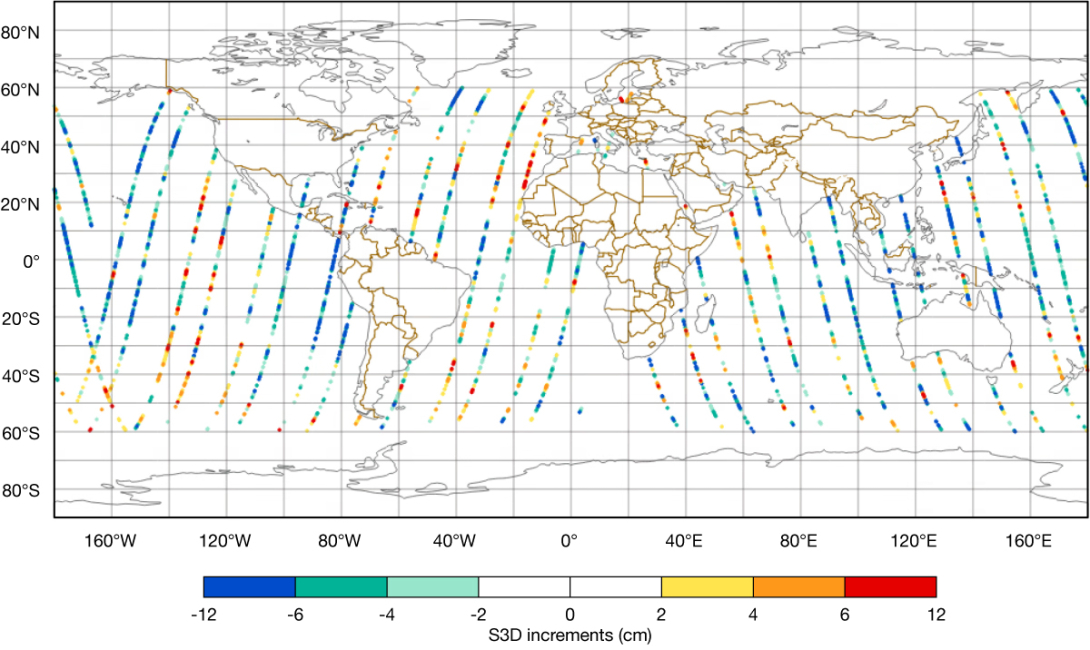
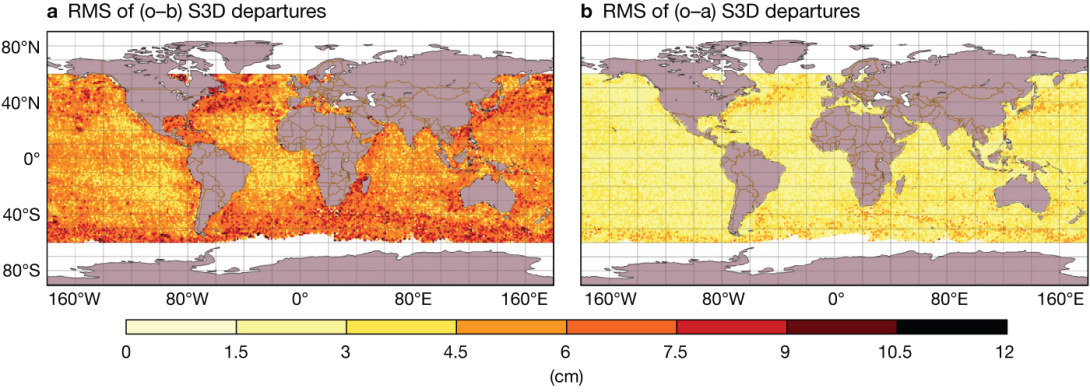
To date, we have not been able to demonstrate a clear positive impact on tropospheric humidity. For example, Figure 5 shows the changes in RMS forecast error statistics for TCWV with and without the S3D observations being assimilated. Overall, the TCWV impact is neutral. One possible reason is that the volume of S3D data is not particularly high in this testing, and we need more observations before a clear impact is seen. To that end, we have started work with Sentinel-6A data, but bias characteristics of these S3D data differ from Sentinel-3A and -3B, and the cause of this difference requires further investigation. Another reason relates to the current specification and partitioning of the background uncertainty. The background SSH uncertainty assumed in the XCV is currently set to 4 cm, whereas the background ZTD uncertainty used in the atmospheric 4D-Var will be around 1 cm (but it is not defined explicitly). This means that the S3D departures will primarily increment the SSH field rather than the atmospheric state when trying to fit the observed values.

The system used to test the S3D assimilation (Figure 2 schematic) produces two SSH analyses: the new SSH analyses in the XCV determined by combining the NEMO forecasts and the S3D observations in 4D-Var; and the SSH analysis produced by the cycling NEMOVAR system, assimilating SLA and other routinely used observation information. These two sets of analyses have been compared with the independent Copernicus Marine Environment Monitoring Service (CMEMS) gridded daily level-4 SSH analysis for the experimental period to investigate whether the SSH analyses are reasonable.
Figure 6 shows the improvement in RMS difference, when comparing the analyses and short-term (background) forecasts against the CMEMS SSH analysis for both the XCV approach (left) and NEMOVAR analyses (right). The negative values (green/blue colours) indicate where the XCV and NEMOVAR analyses are closer to the CMEMS analysis than the forecasts. Conversely, orange/red indicates that the analyses move away from CMEMS.
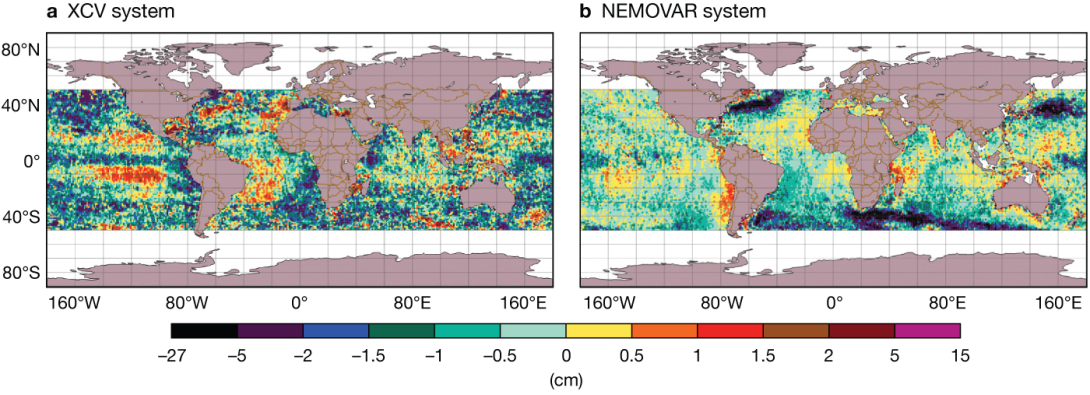
In general, the S3D observations are moving the NEMOVAR forecasts towards the CMEMS analyses and improving the consistency between these two SSH estimates, which is very encouraging. There are clear spatial differences in the XCV and NEMOVAR agreement with CMEMS. NEMOVAR is clearly doing a much better job in the important, eddy active regions, where the SSH forecast errors are known to be larger (Southern Atlantic, Indian Ocean, North Atlantic, North Pacific). It assimilates more altimeters (Jason-3, CrysoSAT-2, Altika) and the SSH field also benefits from sea-surface temperature and salinity observations via balance relationships in the well-tuned, flow-dependent background error covariance matrix. We also find that the S3D data is rejected more frequently in these higher forecast error regions as a result of stricter quality control (QC) in 4D-Var. This is because the QC does not account for spatial variations in the forecast uncertainty of the SSH, and large (o-b) departures caused by the large forecast errors we want to correct are more likely to be rejected. However, it is also noticeable that S3D appears more consistent with CMEMS off the west coast of South America, Africa and India, which is promising.
Summary and further work
In this work, we have assimilated altimeter observations that normally provide sea-surface height information for ocean applications into the atmospheric 4D-Var system, by exploiting recent developments in coupled data assimilation at ECMWF. The work is motivated by many NWP centres routinely assimilating ground-based GNSS observations over land. The neutral atmosphere propagation corrections applied in altimeter SSH processing are essentially equivalent to these ground-based GNSS observations.
This novel use of altimeter information represents a potential new source of humidity information over the ocean, based on an accurate measurement of a time delay. Experiments assimilating Sentinel-3A and -3B delays have been performed for June to August 2020. We have not yet seen a strong impact on the humidity field, but we have demonstrated that this new Earth system approach is now technically feasible.
The SSH analyses produced by 4D-Var assimilating the S3D observations move the SSH forecasts towards the independent, CMEMS level-4 gridded daily analyses, which is very encouraging. In particular, the XCV system appears to perform slightly better than NEMOVAR off the west coast of, for example, South America, Africa and India.
However, the XCV SSH analyses are not as accurate as the NEMOVAR system where the SSH forecast errors are known to be large. This is because NEMOVAR uses more observation data, it benefits from a more sophisticated formulation of the background error covariance matrix, and it uses more appropriate quality control in regions where the SSH forecast errors are large.
This novel use of altimeter measurements is still in its early stages, and there are a number of areas for possible future work. Firstly, we can try to improve the humidity impact by increasing the number of S3D values by adding new altimeters. In preliminary work, the application to Sentinel-6A data highlighted S3D bias differences compared to Sentinel-3A and -3B, which requires further investigation. We can also look at how to couple the S3D information more closely with NEMOVAR. For example, instead of assimilating both S3D and the SLA information in the 4D-Var and NEMOVAR systems, respectively, we could just assimilate the S3D information in the 4D-Var and pass departures to NEMOVAR. However, this would require revising the 4D-Var QC approach to increase S3D usage in the regions of large SSH errors.
Finally, the assimilation methods described here may have relevance to the use of data from a new generation of wide-swath satellite altimeters, such as the Surface Wave Ocean Topography (SWOT) mission. Recent work (Hay et al., 2025) has indicated that humidity structures with horizontal scales less than 80 km can be difficult to correct with a radiometer-based wet tropospheric correction. As a consequence, residual wet delay errors may alias into the SSH estimate. Using the S3D assimilation system – following the example set by Bevis et al. in the 1990s - we could potentially investigate whether wide-swath altimeters are a useful source of humidity information.
Further reading
Abdalla, S. & H. Zuo, 2016: The use of radar altimeter products at ECMWF, ECMWF Newsletter No. 149, 14–19. https://doi.org/10.21957/m2cx1w
Bevis, M., S. Businger, T.A. Herring, C. Rocken, R.A. Anthes & R.H. Ware, 1992: GPS meteorology: Remote sensing of atmospheric water vapor using the global positioning system, J. Geophys. Res., 97(D14), 15787–15801. https://doi.org/10.1029/92JD01517
de Rosnay, P., P. Browne, E. de Boisséson, D. Fairbairn, Y. Hirahara, K. Ochi et al., 2022: Coupled data assimilation at ECMWF: current status, challenges and future developments. Quarterly Journal of the Royal Meteorological Society, 148(747), 2672-2702. https://doi.org/10.1002/qj.4330
Fernandes, M.J., C. Lázaro & T. Vieira, 2021: On the role of the troposphere in satellite altimetry, Remote Sensing of Environment, 252. https://doi.org/10.1016/j.rse.2020.112149
Hay, A., C. Watson, B. Legresy, M. King & J. Beardsley, 2025: Small scale variability in the wet troposphere impacts the interpretation of SWOT satellite observations. Geophysical Research Letters, 52, e2024GL112778. https://doi.org/10.1029/2024GL112778
Massart, S., N. Bormann, M. Bonavita & C. Lupu, 2021: Multi-sensor analyses of the skin temperature for the assimilation of satellite radiances in the European Centre for Medium-Range Weather Forecasts (ECMWF) Integrated Forecasting System (IFS, cycle 47R1), Geosci. Model Dev., 14, 5467–5485. https://doi.org/10.5194/gmd-14-5467-2021
Poli, P., P. Moll, F. Rabier, G. Desroziers, B. Chapnik, L. Berre et al., 2007: Forecast impact studies of zenith total delay data from European near real-time GPS stations in Météo France 4DVAR, J. Geophys. Res., 112, D06114. https://doi.org/10.1029/2006JD007430